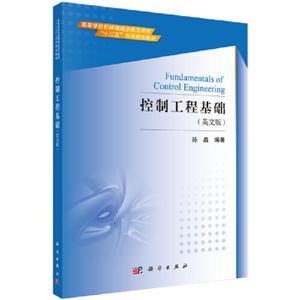扫一扫
关注中图网
官方微博
本类五星书更多>
-
>
中医基础理论
-
>
高校军事课教程
-
>
思想道德与法治(2021年版)
-
>
毛泽东思想和中国特色社会主义理论体系概论(2021年版)
-
>
中医内科学·全国中医药行业高等教育“十四五”规划教材
-
>
中医诊断学--新世纪第五版
-
>
中药学·全国中医药行业高等教育“十四五”规划教材
控制工程基础(英文版) 版权信息
- ISBN:9787030510518
- 条形码:9787030510518 ; 978-7-03-051051-8
- 装帧:平装胶订
- 册数:暂无
- 重量:暂无
- 所属分类:>>
控制工程基础(英文版) 本书特色
控制工程基础属于工程控制论的一个分支,同时也属于经典控制理论领域,重点关注的是现代控制领域内的基础理论和方法。该书重点介绍了经典控制理论领域里的基本原理和方法。尤其强调了机械系统的动态特性和控制理论。同时,对物理系统动态响应的分析和理解也是该书的重点内容。全书主要介绍拉氏变换、机械平移系统的动态特性分析、电气系统的动态特性分析、控制系统基础、控制系统的时域分析法、控制系统的频域分析法、控制系统的稳定性分析和控制系统的误差分析与计算等内容。
控制工程基础(英文版) 内容简介
本书主要介绍拉氏变换、机械平移系统的动态特性分析、电气系统的动态特性分析、控制系统基础、控制系统的时域分析法、控制系统的频域分析法、控制系统的稳定性分析和控制系统的误差分析与计算等内容。
控制工程基础(英文版) 目录
Contents
Preface
Chapter 1 Introduction 1
1.1 System and System Analysis 1
1.2 Modeling the System 2
1.3 Solving the Model 4
1.4 Principle of Automatic Control Systems 5
1.4.1 Control and Control Systems 5
1.4.2 How Does an Automatic Control System Work? 6
1.5 Structure of Control Systems 8
1.5.1 Schematic Diagram for a Typical Automatic Control System 8
1.5.2 Terminologies 9
1.6 Characteristics of Control Systems 10
1.6.1 Stability 10
1.6.2 Accuracy 10
1.6.3 Dynamic Properties 11
1.6.4 Robustness 12
1.7 Classification of Control Systems (to Broadest Sense) 12
1.7.1 Open Loop Control System 12
1.7.2 Closed Loop Control System 13
1.8 Application of Control Theory in Mechanical Engineering Systems 15
1.9 Brief History of Automatic Control 15
1.10 Organization of Book 17
1.11 Drill Problems 17
Chapter 2 Laplace Transform Solution 19
2.1 Definition 19
2.2 Laplace Transforms of Common Functions 20
2.2.1 Step Function 20
2.2.2 Ramp Function 20
2.2.3 Pulse Function 21
2.2.4 Exponential Function 22
2.2.5 Trigonometric Function 22
2.2.6 Power Function 23
2.2.7 Summary 23
2.3 Laplace Transform Properties 24
2.3.1 Multiplication by a Constant 25
2.3.2 Superposition 25
2.3.3 Differential Theorem 25
2.3.4 Integral Theorem 26
2.3.5 Initial Value Theorem 27
2.3.6 Final Value Theorem 27
2.3.7 Shifting Theorem in Time Domain (Delay Theorem) 28
2.3.8 Shifting Theorem in Complex Domain 28
2.3.9 Partial Fraction Method 28
2.4 Laplace Transform Inversion 30
2.4.1 Distinct Poles 31
2.4.2 Repeated Poles 33
2.4.3 Complex Poles 34
2.5 Drill Problems 36
Chapter 3 Formulation and Dynamic Behavior of Translational Mechanical Systems 37
3.1 Introduction 37
3.1.1 Concepts of Mathematical Models 37
3.1.2 Types or Mathematical Models 37
3.2 Variables 37
3.3 Element Laws 39
3.3.1 Mass 39
3.3.2 Friction 40
3.3.3 Stiffness 42
3.4 Interconnection Laws 43
3.4.1 D'Alembert's Law 43
3.4.2 The Law of Reaction Forces 44
3.5 Obtaining the System Model 44
3.5.1 Free-Body Diagrams 45
3.5.2 Parallel Combinations 49
3.5.3 Series Combinations 50
3.6 Drill Problems 53
Chapter 4 Formulation and Dynamic Behavior of Electrical Systems 55
4.1 Element Laws 55
4.1.1 Resistor 55
4.1.2 Capacitor 56
4.1.3 Inductor 56
4.2 Interconnection Laws 57
4.2.1 Kirchhoff's Voltage Law 57
4.2.2 Kirchhoff's Current Law 58
4.2.3 The Nodal Method of Electrical Network Analysis 58
4.3 Analogue relationships among different systems 59
4.4 Examples 60
4.5 Drill Problems 62
Chapter 5 Fundamentals of Control Systems 63
5.1 Representation of Control Systems 63
5.2 The Transfer Function 63
5.2.1 Definition of the Transfer Function 64
5.2.2 Properties of the Transfer Function 65
5.2.3 The Rational Polynomial Form of a Transfer Function 66
5.2.4 Transfer Function of Elements in Series Connection 67
5.2.5 Transfer Function of Elements in Parallel Connection 68
5.2.6 Remarks 69
5.3 The Transfer Function for Typical Links 70
5.3.1 Proportion Link 70
5.3.2 Integral Link 71
5.3.3 Inertial Link 72
5.3.4 Differential Link 74
5.3.5 Oscillation Link 75
5.4 Function Block Diagrams 76
5.4.1 Introduction 76
5.4.2 Summing Point and Tie Point 76
5.4.3 Terminologies 77
5.4.4 Simplification of the Function Block Diagram 79
5.5 Plot the Function Block Diagrams 88
5.6 Signal Flow Diagrams 92
5.6.1 Introduction to Signal Flow Diagrams 92
5.6.2 Draw the Signal Flow Diagram 92
5.6.3 Mason's Gain Formula 94
5.7 Drill Problems 96
Chapter 6 Time Response Analysis of Control Systems 99
6.1 Introduction 99
6.2 Time Response from Transfer Function 100
6.2.1 Response of First-Order System 100
6.2.2 Response of Second-Order System 104
6.2.3 Approximate Analysis of High-Order System 110
6.3 Performance Specifications in Time Domain 114
6.3.1 Performance Specifications of First-Order System 114
6.3.2 Performance Specifications of Second-Order System 116开
6.4 Drill Problems 121
Chapter 7 Frequency Response Analysis of Control Systems 123
7.1 Concepts 123
7.2 Graphical Descriptions: Nyquist Diagram and Bode Diagram 127
7.2.1 Simple Rules for Plotting Nyquist Diagram 127
7.2.2 The Nyquist Diagrams for Typical Links 128
7.2.3 Simple Rules for Plotting Bode Diagrams 134
7.2.4 The Bode Diagrams for Typical Links 139
7.3 The Open Loop Bode Diagram of Control System 151
7.4 Minimum Phase Systems 155
7.5 Nyquist Stability Criterion 158
7.5.1 The Explanation for Nyquist Stability Criterion 158
7.5.2 Some Tips for Nyquist Stability Criterion 16开0
7.5.3 Nyquist Stability Criterion for Minimum Phase System 16开1
7.5.4 Stability Margin 16开1
7.6 Drill Problems 16开7
Chapter 8 Stability Analysis of Control Systems 16开8
8.1 Stability 16开8
8.2 Conditions for
展开全部
书友推荐
- >
上帝之肋:男人的真实旅程
上帝之肋:男人的真实旅程
¥19.3¥35.0 - >
月亮与六便士
月亮与六便士
¥15.1¥42.0 - >
李白与唐代文化
李白与唐代文化
¥8.9¥29.8 - >
伊索寓言-世界文学名著典藏-全译本
伊索寓言-世界文学名著典藏-全译本
¥9.3¥19.0 - >
史学评论
史学评论
¥22.7¥42.0 - >
山海经
山海经
¥19.7¥68.0 - >
大红狗在马戏团-大红狗克里弗-助人
大红狗在马戏团-大红狗克里弗-助人
¥3.5¥10.0 - >
罗曼·罗兰读书随笔-精装
罗曼·罗兰读书随笔-精装
¥31.9¥58.0
本类畅销
-
食品添加剂
¥33.5¥45 -
VB语言程序设计
¥29.9¥39.8 -
C语言程序设计习题与实验指导
¥9.1¥18 -
地下建筑结构-(第三版)-(赠课件)
¥49.4¥55 -
模具制图
¥37.8¥49 -
工程机械结构认知
¥10.5¥22





















